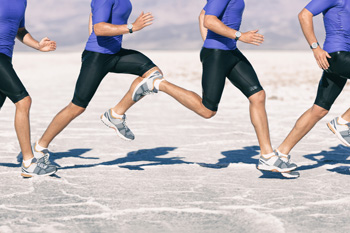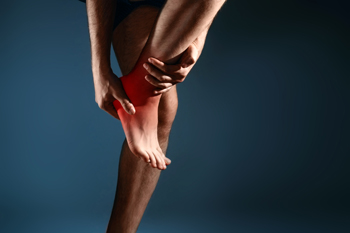July 2022
Four Categories of Broken Toes

The bones in the toes are known as phalanges, and the big toe consists of two phalanges. There are four types of broken toes that can occur, compressed, comminuted, displaced and non-displaced. In a comminuted fracture, the bone can break into several fragments. When force presses the ends of the bones towards the center, a compressed fracture has occurred. A bone that is moved out of its normal position is indicative of a displaced fracture, while a broken bone that stays in position is called a non-displaced fracture. The most common toe to break is the pinky toe, and this is often done by jamming it into a piece of furniture, or if something heavy drops on it. If the break is mild, buddy taping may be an effective way to promote stability to the toe as the healing process begins. This is done by taping the affected toe to the toe next to it, which may help keep it straight. If you suspect you have broken your toe, a podiatrist can provide an X-ray that can determine the extent of the fracture, and offer you correct treatment options.
A broken toe can be very painful and lead to complications if not properly fixed. If you have any concerns about your feet, contact one of our podiatrists from Piedmont Podiatry Associates. Our doctors will treat your foot and ankle needs.
What to Know About a Broken Toe
Although most people try to avoid foot trauma such as banging, stubbing, or dropping heavy objects on their feet, the unfortunate fact is that it is a common occurrence. Given the fact that toes are positioned in front of the feet, they typically sustain the brunt of such trauma. When trauma occurs to a toe, the result can be a painful break (fracture).
Symptoms of a Broken Toe
- Throbbing pain
- Swelling
- Bruising on the skin and toenail
- The inability to move the toe
- Toe appears crooked or disfigured
- Tingling or numbness in the toe
Generally, it is best to stay off of the injured toe with the affected foot elevated.
Severe toe fractures may be treated with a splint, cast, and in some cases, minor surgery. Due to its position and the pressure it endures with daily activity, future complications can occur if the big toe is not properly treated.
If you have any questions please feel free to contact one of our offices located in Greenville, and Easley, SC . We offer the newest diagnostic and treatment technologies for all your foot and ankle needs.
There Are Two Arches in the Foot

The arch contributes to making the human foot stiff. Medical research has indicated there are two arches,the MLA (medial longitudinal arch) and the TTA (transverse tarsal arch). The middle of the foot contains the TTA, and covers the width of the foot. The TTA plays a more significant role in how stiff the foot is. The MLA runs on the inside of the foot from the heel to the toes. Each foot is made up of 26-28 bones, and together they account for nearly a quarter of the bones in the body. The plantar fascia is found within the MLA, and is responsible for 25 percent of foot stiffness. There is a test that is performed on cadaveric feet, known as the three-point bending test. This involves cutting the tissue between the long bones of the feet, known as the metatarsals. When the tissue is severed, the stiffness in the foot is reduced by half. Patients who are interested in learning more about the arch and foot structure may wish to speak with a podiatrist for more information.
If you have any concerns about your feet, contact one of our podiatrists from Piedmont Podiatry Associates. Our doctors can provide the care you need to keep you pain-free and on your feet.
Biomechanics in Podiatry
Podiatric biomechanics is a particular sector of specialty podiatry with licensed practitioners who are trained to diagnose and treat conditions affecting the foot, ankle and lower leg. Biomechanics deals with the forces that act against the body, causing an interference with the biological structures. It focuses on the movement of the ankle, the foot and the forces that interact with them.
A History of Biomechanics
- Biomechanics dates back to the BC era in Egypt where evidence of professional foot care has been recorded.
- In 1974, biomechanics gained a higher profile from the studies of Merton Root, who claimed that by changing or controlling the forces between the ankle and the foot, corrections or conditions could be implemented to gain strength and coordination in the area.
Modern technological improvements are based on past theories and therapeutic processes that provide a better understanding of podiatric concepts for biomechanics. Computers can provide accurate information about the forces and patterns of the feet and lower legs.
Understanding biomechanics of the feet can help improve and eliminate pain, stopping further stress to the foot.
If you have any questions please feel free to contact one of our offices located in Greenville, and Easley, SC . We offer the newest diagnostic and treatment technologies for all your foot and ankle needs.
Painful Foot Conditions

Foot pain is common and can arise from many causes. Injury or trauma, like a fracture, or medical conditions, like diabetes, can affect the feet and cause pain. Some painful foot conditions are presented here. Care must be taken that the tendon does not rupture. Plantar fasciitis happens when the ligament running across the bottom of the foot tightens or tears. With this condition, one feels heel pain that is worse after rising from sleep or prolonged sitting. A Morton’s neuroma is a nerve condition that impacts the nerve that carries sensation to the toes. Persistent inflammation of the nerve will lead one to feel as if there is a marble between the third and fourth toes. It causes ball of the foot pain or numbness in the toes. Gout is a painful form of arthritis that arises from a buildup of uric acid crystals in the joints and often starts in the big toe but can also affect the ankles and heels. A foot fracture is when one of the 26 bones in the foot break. Diabetic neuropathy is a nerve disorder that can be a complication of diabetes and lead to problems in the feet. It causes numbness and tingling in the feet, as well as burning pain. If you have foot pain, it is important to see a podiatrist so that you obtain a proper diagnosis and treatment that is right for you.
Foot Pain
Foot pain can be extremely painful and debilitating. If you have a foot pain, consult with one of our podiatrists from Piedmont Podiatry Associates. Our doctors will assess your condition and provide you with quality foot and ankle treatment.
Causes
Foot pain is a very broad condition that could be caused by one or more ailments. The most common include:
- Bunions
- Hammertoes
- Plantar Fasciitis
- Bone Spurs
- Corns
- Tarsal Tunnel Syndrome
- Ingrown Toenails
- Arthritis (such as Gout, Rheumatoid, and Osteoarthritis)
- Flat Feet
- Injury (from stress fractures, broken toe, foot, ankle, Achilles tendon ruptures, and sprains)
- And more
Diagnosis
To figure out the cause of foot pain, podiatrists utilize several different methods. This can range from simple visual inspections and sensation tests to X-rays and MRI scans. Prior medical history, family medical history, and any recent physical traumatic events will all be taken into consideration for a proper diagnosis.
Treatment
Treatment depends upon the cause of the foot pain. Whether it is resting, staying off the foot, or having surgery; podiatrists have a number of treatment options available for foot pain.
If you have any questions, please feel free to contact one of our offices located in Greenville, and Easley, SC . We offer the newest diagnostic and treatment technologies for all your foot care needs.
Wounds That Don't Heal Need to Be Checked
Roll Before You Run

Although running can be an excellent way to burn your calories for the day, if you do not properly prepare your body beforehand, you may be setting yourself up for a foot injury. One way to help prevent an injury, is to roll out your feet using a foam foot roller or tennis ball. Often when runners do not roll out their feet before runs, their foot muscles become tighter and more restrictive, which can increase the stress felt on the ankle. This consequently increases the risk of injuries. By rolling out your feet, you can loosen the tissue and muscles in your feet. Besides preventing injuries, this technique also gives you more flexibility and movement in other parts of your body, including your legs. When rolling your feet, you might consider sitting to control the amount of pressure put on your feet, spending approximately two minutes per foot. While rolling out their feet, runners often look for areas on their feet that carry a particularly large amount of tension or tightness. Don’t take chances when it comes to your feet. You might consider reaching out to a podiatrist who can best help you prevent injuries during your runs.
Exercising your feet regularly with the proper foot wear is a great way to prevent injuries. If you have any concerns about your feet, contact one of our podiatrists of Piedmont Podiatry Associates. Our doctors will treat your foot and ankle needs.
How to Prevent Running Injuries
Many common running injuries are caused by overuse and overtraining. When the back of the kneecap starts wearing out and starts causing pain in your knee, this is commonly referred to as runner’s knee. Runner’s knee is a decrease in strength in your quadriceps and can occur if you’re not wearing properly fitted or supporting shoes. To prevent runner’s knee, focusing on hip strengthening is a good idea, as well as strengthening your quads to keep the kneecaps aligned.
What Are Some Causes of Running Injuries?
- One cause of a common running injury is called iliotibial band syndrome.
- Plantar fasciitis is also another common injury.
- Stress fractures can occur from overtraining, lack of calcium, or even your running style.
Best Ways to Prevent Running Injuries
- Wear footwear that fits properly and suits your running needs.
- Running shoes are the only protective gear that runners have to safeguard them from injury.
- Make a training schedule. Adding strengthening exercises as well as regular stretching can help keep you strong and limber and can lessen the possibility of injuries.
- Stretching keeps muscles limber; this will help you gain better flexibility.
If you have any questions please feel free to contact one of our offices located in Greenville, and Easley, SC . We offer the newest diagnostic and treatment technologies for all your foot and ankle needs.





